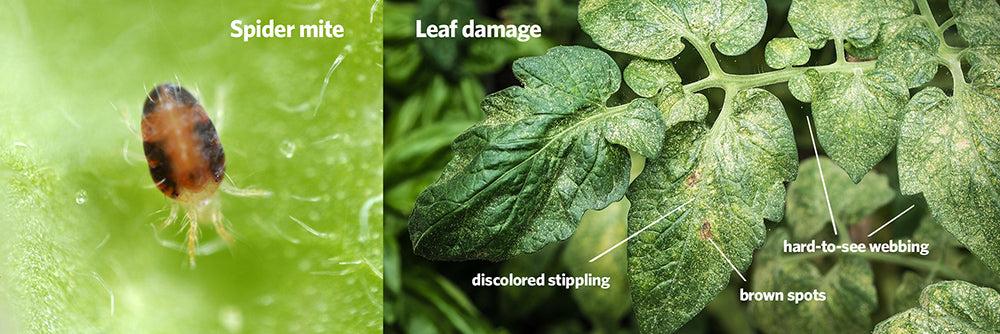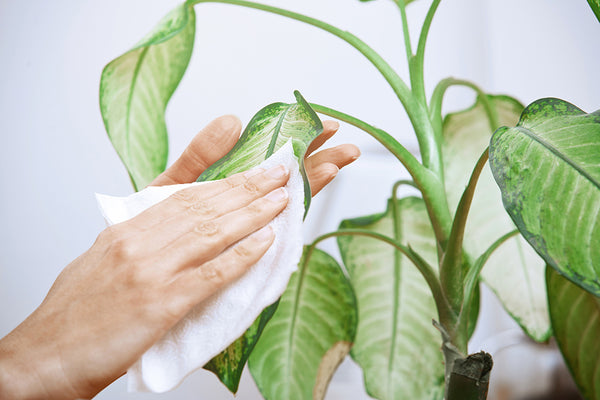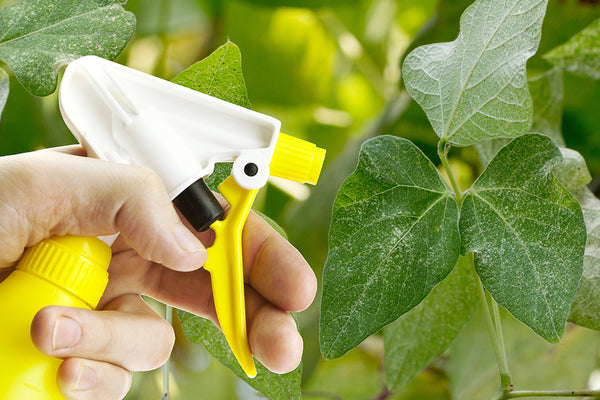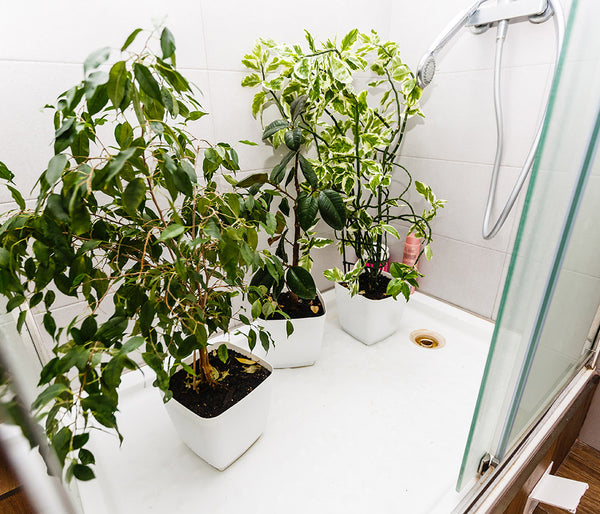From a distance, your houseplant with browning leaves might just look a little parched… but take a closer look, hold the plant up to the light and look under the leaves – if you see delicate webbing and tiny little dots moving around, you’ve got a case of spider mites on your hands!
Symptoms
Let’s take a look at how you can spot these pests. The first thing you’re likely to notice is patterns of silvery dots or stippling on the leaves of your plant. Looking closer, you will see small, delicate webs in corners of stems or underneath leaves with what look like tiny white dots scattered throughout. Those are spider mites! It’s hard to see them until their population explodes, and be aware that spider mites also come in brown and red. Other signs of their damage are brown spots and holes in leaves where these pesky critters have chewed straight through.
You are watching: How To Get Rid Of Spider Mites On Houseplants

Spider mites are difficult to see with the naked eye, but adults have eight legs and little oval bodies and can come in a variety of colors. Sometimes called webspinning mites, these pests are particularly pesky because of their ability to double their population every couple of weeks. It takes a spider mite just a week to become full grown, and a couple more weeks to lay hundreds of eggs on the undersides of leaves. They breed quickly in warm, dry conditions and can be a bigger problem in the winter when your heating system runs and dries out the air.
Where do they come from? Spider mites are wind surfers that range over wide areas by riding their webbing on the breeze. Their mobility and extremely small size makes it easy for them to arrive unnoticed, even through screens on windows and doors.
Diagnosis
Spider mites feed off of materials from plant cells, and as they continue to damage your plant, leaves will become speckled, wilt, turn brown or yellow, and fall off. The spider mites target the ‘stomata’ of leaves – kind of like pores that regulate water retention in different environments – making it vulnerable to water loss. Eventually, when enough leaves shrivel up and fall from the plant, the plant can weaken and die. It’s possible to quell a spider mite problem, but it will require dedication.
Ready to take on the challenge to save your plants? Read on for prevention and treatment methods!
Prevention

1. CLEAN THOSE LEAVES
Spider mites like dusty leaves on plants that are suffering from water stress. A good way to discourage them is by wiping dirty leaves periodically and making sure your watering schedule is right for your plant. You can also try using a leaf shine periodically.
2. KEEP HUMIDITY UP
Read more : How to bring an outside cat indoors
Since spider mites like it dry, keeping the air humid around your plants is a great way to deter them from settling on your plant. Use a humidifier for the room, periodically spray a fine mist on your plants, or leave a container of water to evaporate nearby. You can also try adding peat moss to your soil and making sure your plant isn’t in direct sunlight by using a sheer curtain.
3. DEBUG FOR DEPARTURE
If you like to keep plants outside during the summer, make sure to take precautions to debug your plants before bringing them back inside.
Treatment
Note: Make sure that spider mites are actually living on your plant before treating it. Often, colonies of mites are already gone before their damage is noticed. Try shaking some leaves you suspect of having spider mites over a sheet of plain white paper to check for little crawlies, which will show up as little moving spots, or looking closely at webbing for movement.
1. PRUNE & ISOLATE
The first thing you should do when you discover spider mites is to isolate the plant away from other plants. You can try to prune out sections with visible webbing, disposing of them immediately & carefully. Then, use one or more of the methods below to treat the rest of the plant. Remember to clean and disinfect the area that the plant was in before you moved it, as well as your hands afterwards.

2. SPRAY WITH PLANT-BASED MITICIDES
Pick up some commercially available miticides that use natural ingredients to get the job done, leaving the plant unharmed. Make sure to test your spray on a leaf first before spraying the entire plant. Pro Tip: Every once in a while, mix up the product you’re spraying so that the spider mites won’t build up an immunity to it. Here’s a quick list of effective sprays:
- Pyrethrum: Derived from a relative of the chrysanthemum, this miticide is the best to begin with. Some mite species can develop a resistance to it, so keep an eye on your plant after spraying.
- Cinnamite: This pesticide is derived from cinnamon oil and is non-hazardous. It won’t kill eggs, but it is effective for killing adult spider mites. Spray this one on your plant every 3 days over a couple of weeks to make sure you get all of them!
- Neem oil: Neem oil is an effective treatment for all kinds of pests. It’s derived from the nuts of the Neem evergreen tree and will not only treat the problem you’re having right now, but also provide some repellant for new critters after. You’ll have to regularly re-apply neem oil as it takes a while to become effective.
- Rosemary oil: You will need to dilute rosemary oil with water, but it can be an effective treatment for spider mites, especially for herbs and plants you want to harvest and eat later, as it is non-toxic to humans.
3. MAKE YOUR OWN HERBAL TEA MITICIDE
Read more : How to Set Up an Aquatic Turtle Tank
This tea is to die for. Mix 1 tablespoon ground cinnamon, 1 tablespoon ground cloves, and 2 tablespoons of Italian seasoning in a quart of water. Boil the water, then take off the heat. Once it’s cooled slightly, add 2 tablespoons of crushed fresh garlic. Rest until cool, then strain. Now, with your mixture, add a splash of dish soap and pour into a spray pottle. Shake well and spray the underside of the leaves with your DIY miticide every 3 days for a couple weeks!
4. PUT HOUSEHOLD CHEMICALS TO GOOD USE
If you don’t want to go out and get any fancy miticides or create your own, you can easily make use of what you have in the medicine cabinet or your kitchen at home:
- Rubbing alcohol: Mix rubbing alcohol with water to spray onto your plant, or use it to manually wipe off leaves. For sensitive plants, try 1 part alcohol to 3 parts water, and for hardier plants, try a 1 to 1 mixture.
- Dish soap solution: Using a mixture of 1 liter of warm water and 1 teaspoon of liquid dish soap, either mix the solution well in a spray bottle, or mix it into a bucket and wash the plant with a cloth or sponge. Re-apply regularly for best results.
5. MIGHTY MITES
Don’t want to deal with re-applying sprays regularly? Here’s a one-step solution that, while it might freak some plant parents out, is a foolproof method for getting rid of spider mites: you can purchase predatory mites that feed on spider mites, release them onto your plant, and let them take care of the rest. One type of predatory mites that works for this is Phytoseiulus persimilis. You can also employ ladybugs, lacewing, and others to get the job done.
Note: If you go this route, avoid miticides and pesticides that might harm the good mites as well as the bad ones! Rosemary oil won’t harm the good mites, so try that instead.

6. GIVE YOUR PLANT A SHOWER
One way to fight mites is to regularly hose down your plant with a handheld shower nozzle using room temperature water, paying close attention to the underside of leaves especially. When the mites are gone, continuing to give your plant a shower every once in a while can help prevent other pests from taking hold.
7. CONSIDER CUTTING YOUR LOSSES
No one wants to lose their favorite plants, but if those mites are still hanging on after you’ve tried everything, you might consider throwing out infested plants and starting anew after thoroughly cleaning the areas that they were in.
We hope these tips and tricks help you to eradicate these miniscule menaces once and for all! Good luck, plant fam!
Source: https://gardencourte.com
Categories: Outdoor


